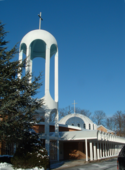Eparchie Newton
| Eparchie Newton | |
 | |
| Basisdaten | |
|---|---|
| Kirche eigenen Rechts | Melkitische Griechisch-Katholische Kirche |
| Staat | Vereinigte Staaten |
| Kirchenprovinz | Immediat |
| Diözesanbischof | François Beyrouti |
| Emeritierter Diözesanbischof | Nicholas James Samra |
| Gründung | 1966 |
| Fläche | 9.826.675 km² |
| Pfarreien | 46 (2021 / AP 2022) |
| Einwohner | 322.755.353 |
| Katholiken | 30.000 (2021 / AP 2022) |
| Anteil | 0 % |
| Diözesanpriester | 58 (2021 / AP 2022) |
| Ordenspriester | 3 (2021 / AP 2022) |
| Katholiken je Priester | 492 |
| Ständige Diakone | 61 (2021 / AP 2022) |
| Ordensbrüder | 7 (2021 / AP 2022) |
| Ordensschwestern | 2 (2021 / AP 2022) |
| Ritus | Byzantinischer Ritus |
| Liturgiesprache | Englisch, Arabisch |
| Kathedrale | Annunciation Cathedral |
| Website | www.melkite.org |
Die Eparchie Newton (lat.: Eparchia Neotoniensis Graecorum Melkitarum) ist eine in den USA gelegene Eparchie der melkitischen griechisch-katholischen Kirche mit Sitz im Bostoner Stadtteil Roslindale.
Geschichte

Die Eparchie Newton wurde am 10. Januar 1966 durch Papst Paul VI. mit der Apostolischen Konstitution Byzantini Melkitarum als Apostolisches Exarchat Vereinigte Staaten für die melkitischen Gläubigen errichtet.[1] Das Apostolische Exarchat Vereinigte Staaten für die melkitischen Gläubigen wurde am 28. Juni 1976 durch Paul VI. mit der Apostolischen Konstitution Cum apostolicum zur Eparchie erhoben und in Eparchie Newton umbenannt.[2]
Ordinarien
Apostolische Exarchen der Vereinigten Staaten
- Justin Abraham Najmy BS, 1966–1968
- Joseph Elias Tawil, 1969–1976
Bischöfe der Eparchie Newton
- Joseph Elias Tawil, 1976–1989
- Ignatius Ghattas BS, 1989–1992
- John Adel Elya BS, 1993–2004
- Cyrille Salim Bustros SMSP, 2004–2011, dann Erzbischof von Beirut und Jbeil
- Nicholas James Samra, 2011–2022
- François Beyrouti, seit 2022
Siehe auch
Weblinks
- Eintrag zu Eparchie Newton auf catholic-hierarchy.org
- Eintrag zu Eparchie Newton auf gcatholic.org (englisch)
- Homepage der Eparchie Newton (englisch)
Einzelnachweise
- ↑ Paulus VI: Const. Apost. Byzantini Melkitarum, AAS 58 (1966), n. 8, S. 563f.
- ↑ Paulus VI: Const. Apost. Cum apostolicum, AAS 69 (1977), n. 2, S. 75f.
Auf dieser Seite verwendete Medien
Autor/Urheber: TUBS
Lage der Vereinigten Staaten auf der Erde.
Autor/Urheber: Chonak, Lizenz: CC BY-SA 3.0
Our Lady of the Annunciation Melkite Greek-Catholic Cathedral, West Roxbury (Boston), Massachusetts, exterior.
(c) I, SajoR, CC BY-SA 2.5
Coat of arms of the Eparchy of our Lady of the Annunciation of Newton (USA), of the Melkite Greek Catholic Church.
Blason: Eparchy of Newton: Azure, a sun resplendent d’or charged with the Greek letters IC XC sable, in the nombril a crescent d’argent and in the base the Greek letters MR OU of the second; a chief paly of thirteen d’argent and gules.
Significance: Our eparchial coat-of-arms were first registered and granted at the establishment of the Melkite Greek-Catholic Exarchate for the United States in 1966. They remained unchanged in 1976, during the Bicentennial year of our nation’s independence, when the exarchate became the Melkite Greek-Catholic Eparchy of Newton. These same arms have been borne continuously by the Melkite Church in the United States except for a year or two in the late 1980’s when a variation of the same arms was used, but with the placement of the sun and moon at the top of the shield and stripes below. However, the arms reverted to its original granted form after a short period of time and has remained the same since.
The field of a blue shield and thirteen alternating white and red stripes recalls the coat of arms of the United States and the original thirteen colonies. The Eparchy of Newton is headquartered in one of those thirteen colonies and close to the very birthplace of the American Revolution. The resplendent Sun is symbolic of the Christ who is lauded in the ancient vespers hymn “Phos Hilaron” – “O Joyful Light of the Father’s glory.” The sun is further charged with the Greek monogram for Jesus Christ – IC XC. Significantly, for an eparchy with its cathedral dedicated to the Annunciation, a crescent moon in the base is symbolic of the Holy Theotokos (Rev. 12:1) while the letters MR OU are the Greek monograms for the Mother of God.
A heraldic crown surmounts the shield of a Melkite eparchy. Although somewhat reminiscent of the episcopal mitre, the heraldic crown above Melkite patriarchal and eparchial arms is actually more akin to a royal crown and is symbolic of both dignity and jurisdiction. Additionally, the eparchial arms may also be backed with a paterissa – the pastoral staff used by a bishop.
Reference:



